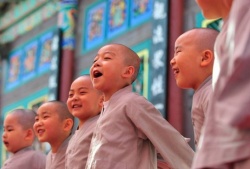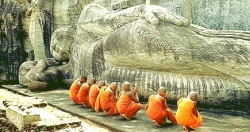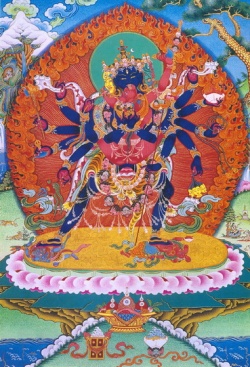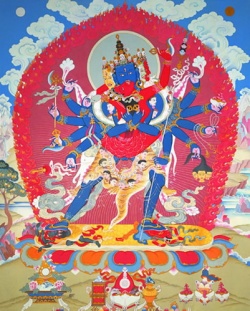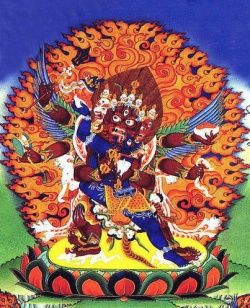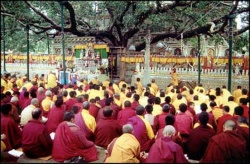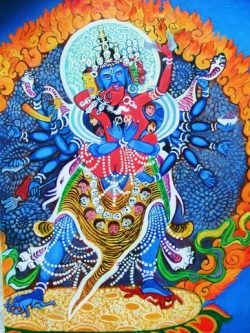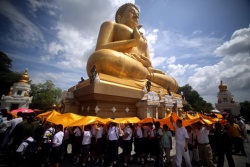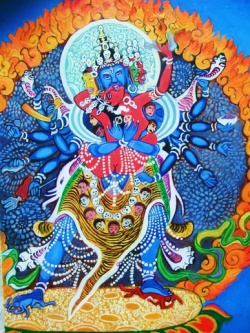The Buddha's Analysis Of Mind By U Tin U (Myaung)
Preface
About the Manuscript
The present book was originally written by U Tin U (Myaung) in Myanmar and has been published in 1999 under the title: "Myat Buddha nee kya seik ko lai lar chin". The author has translated it into English for a serialized publication in the DPPS Magazine. This manuscript comprises two portions: the typed portion is the installment contributions, 14 in number; the second portion in 41 handwritten pages is a continuation of the book. This portion has not gone to the press yet.
The author wishes to ask for the indulgence of the publishers to put up with the shortcomings of the script. Correctness of the entire work of course is assured.
U Tin U (Myaung)
25th February 2000
The Author
U TIN U retired from public service and volunteered for the Pitaka translation project launched by the Myanmar Pitaka Association (MPA) in 1981, first as a translator and later as an editor. In 1991 the MPA was voluntarily wound up and its Editorial Committee was renamed the Honorary Editorial Committee of the Department for the Promotion and Propagation of the Sasana (DPPS). U Tin U as an editor is member of the committee. He was awarded the religious title of Mahasaddhammajotikadhaja in 1998 by the State in recognition of his distinguished contribution to the cause of spreading the Buddha's Teaching.
Namotassabhagavato arahato sammasambuddhassa
Veneration to the Exalted One, the Homage-worthy, the Perfectly Self-Enlightened
THE AUTHOR'S ASPIRATION
In all humility and devotion, I pay homage to the All-knowing Buddha, endowed with the eighteen kinds of' exceptional attributes, etc., and whose Wisdom must not be or cannot be fathomed (acinteyya). In consequence of this my veneration, may I be possessed of a mind that is clear, expansive and allied with intelligence, so that I may be able to write a book on Mind (citta) as expounded in the Buddha's Abhidhamma, in such intelligible expressions as would help the readers gain a good understanding of the nature and working of the human mind. And may those readers, having a grasp of the human mind, each gets established in virtue.
Introduction
Name Buddhaya siddham
Homage to the Buddha: success be to me!
It has been said that the main difference between man and animal lies in the fact that the former has intelligence. The inference that can be drawn from this statement is that 'a man lacking in intelligence is no better than an animal.' In daily usage a dullard is often called 'a bovine species', a rather wicked epithet, but perhaps his stupidity makes him deserve such an epithet.
Our main concern (or proposition) here is that a person is expected to have the normal intelligence that a man should have.
As the twentieth century is drawing to a close, people are saying that human civilization has advanced in our world. Many believe that standards of living have risen. They allude this to the progress of Science. True that there have been technological innovations, almost of daily occurrence, thanks to advancements in science. In as much am marvellous technological achievements beneficial to man have been recorded, there are numerous breakthroughs in the field of mass destruction. Almost every day, awesome inventions are vying with one another, threatening mankind with universal extinction. Indeed, the air we breathe is polluted both in the physical and figurative senses. The modern man wants to boast that he is in control of the physical world.
Amidst this unheard-of (so-called) 'progress', natural disasters, wherein human contribution is not yet evident, are occurring at an unprecedented rate. Meantime, inhuman behaviour in many societies has caused horrendous mass killings by the million among mankind. The death rate surpasses that of the last War. Such a seething state of the world today naturally befuddles the average person. He feels quite helpless.
But where else could one find help but within himself? "Oneself is the refuge for one" (attahi attano natho), so said the Buddha. This refuge within oneself is none ether than one's own mind, that is, one's own state of mind.
A person with a pure and noble mind is forearmed with the fortitude to face the uneven nature of worldly conditions. So he does not pine away for his painful misfortunes. Nor does he get puffed up when highly praised. He takes the ups and downs of life merely as resultants of his past deeds and can keep his calm. He may feel a little distress under misfortune, but that is just human. He will never explode with anger or resort at foul means to assert his rights. This ability to withstand the vicissitudes of life with a proper attitude, in fact, is due to the gentle influence of the Dhamma shown by the Buddha. The teaching of the Buddha in the form of the Three Pitakas have been well inherited by the peoples of Myanmar along with other peoples who have embraced Theravada Buddhism. This deals with citta or mind which is the cornerstone of Abhidhamma, one of the Three Pitakas. The subject is treated in a reasonably short manner of presentation.
Of the Three Pitakas, Abhidhamma Pitaka surpasses the ether two in that it deals with the Buddha's Doctrine in the ultimate sense, shorn of any reference to a person or place, hence it is 'special' (abhi)Dhamma. The Abhidhamma of the Buddha comprises seven books, namely:
1: Dhammasangani,
2: Vibhanga,
3: Dhatukatha,
4: Puggalapannatti,
5: Kathvatthu,
6: Yamaka,
7: Patthana.
These seven books in Myanmar script of Pali are printed in 18 volumes, 12 texts as approved by the Sixth Synod, 3 Commentaries and 3 Sub-commentaries, all of them in Pali. Many of them have been translated into Myanmar. Whether in Thai or in Myanmar translations, these books are difficult to understand due to their abstruse and profound nature. A student needs guidance of a competent teacher to get at their meaning.
The First of the Abhidhamma books is Dhammasangani which is the very foundation of Abhidhamma. Therein the Buddha proclaims the principal outline called Matiki, which has all the ultimate realities [i.e., Citta (mind), cetasika (mental concomitants), rupa (matter) and Nibbana), each of which is grouped under three headings, and thus are called Tika matika. There are 22 such groups, the first of which is called Kusala tika. It assigns all ultimate realities to three classes: 1, meritorious dhamma; 2, demeritorious dhamma; 3, dhamma that are neither meritorious nor demeritorious. It may well be said that anyone who cannot distinguish meritoriousness and demeritoriousness is not worth having a human existence. In other words, his being born in this human world is an utter loss. This is because if, as a human being, he does not knew what is wholesome action and what is evil action, he is liable to blunder all through life. For the human mind usually feels at home in evil. And evil actions beget evil consequences not only here and now, but also in the hereafter. After his death he is destined to be reborn in one of the four miserable existences of apaya.
Hence, anyone in his right senses should be able to distinguish between good and evil. When is the mind in a good or meritorious state? And when is it in an evil or demeritorious state? What are the causes that make the mind meritorious or demeritorious? The nature of mind is analysed in fine detail by the Buddha in his Abhidhamma. To help the man in the street get acquainted with the basic principles of Abhidhamma, a number of commentarial literature have been produced by learned theras of yore. The line of such commentarial expositions thorough the ages is a long one, enriching the student's knowledge of Abhidhamma. Among the smaller commentaries the 'Abhidhammattha sangaha' is acknowledged by the learned as the most reliable. It purports to provide the beginner with a condensed exposition of all that are contained in the seven books of Abhidhamma. The method of condensation is not based on each of the seven books, but it is a compendium of all the facts contained in those books under suitable headings. It portrays the essential facts under nine headings, forming nine chapters, namely:
l, Consciousness;
2, Mental concomitants;
3, Miscellaneous section;
4. Analysis of Thought-processes;
5, Process-freed Consciousness;
6, Analysis of matter;
7, Abhidhamma categories;
8, Compendium of Relations;
9, Mental culture.
The arrangement of Abhidhammattha sangaha is so carefully made out that it serves as a Primer of Abhidhamma Pitaka.
The present book is a study of the mental concomitants or cetasika, the second chapter of the Compendium. The purpose of the book is threefold: (1) to let the student acquainted with mental states, called mental concomitants, thereby making him well acquainted with mind itself; (2) to enable him to tell wrong from what is right; (3) to let him understand and cherish the essential features of Myanmar Buddhist cultural tradition that is rooted in Theravada Buddhism. An ordinary person is consumed by the eleven fires such as greed, hatred, bewilderment, etc., which are the defilements that arise in the mind. Whatever fire of defilement that arises in one's mind can only be quelled by the cooling water of one's purity of mind. Such mastery of one's own mind ought to be well demonstrated by us Myanmars as practising Buddhists. It is the author's sincere hope that our people may be able to show by example how to live a good, peaceful life with proper attitude of mind.
The author of the Abhidhammattha sangaha was Maha Thera Anuruddha, who resided for most of his life in the Island of Sinhala (Sri Lanka) during the period not later than the twelfth century. Records say that he was born in the town of Keveri in Kanchapura state in the province of the Cholas. Kanchipura state is called Conjiveram these days, and Keveri still is known by its old name, a seaport town at the mouth of River Keveri. It is said that Maha Thera Anuruddha wrote this book at the request of one Namba while the former was residing at the Mula Soma monastery at Anuradha. His book, though small in size, has won wide acclaim. It has been translated from the original Pali into several languages including English, German, Thai, Hindi, etc, not to mention the numerous Sub-commentaries and Expositors in Pali.
What is Mind?
Mind in Myanmar language is 'Seit', an adopted word derived from the Pali word citta. There are many Myanmar words borrowed from Pali used both in daily speech and in writing. Many of these words, when thus adopted, have their meaning changed from the original. We shall have occasion to say on this, later.
In the mean time we will dwell on citta or mind only.
In Myanmar language we speak of someone having a good mind, or a bad mind; or having a kind heart. These usages carry only superficial meanings of the word citta. To have a fair understanding of its meaning, we need to discuss about the four ultimate realities that are basic to the world and that are unchanging at all times. The four are: citta (mind), cetasika (mental concomitants), rupa (matter) and Nibbana. In Pali they are termed as Paramattha Dhamma.
The term paramattha is of wide significance. It also has been adopted into the Myanmar vocabulary as 'paramat'. To state briefly, the four paramatthas or ultimate realities are true to their own nature, not liable to change their real essence. All the world can be analysed into just these four ultimate realities; there can be no fifth one. A good grasp of the four ultimate realities is something that lies within the province of the wise ones. They are indeed abstruse. They may be considered as objects of the Ariya's mind. Since the four ultimate realities can be comprehended only through wisdom, for a worldling they remain lost in worldly usage. Reality is marred by worldly usage, as if a big mountain were standing between reality and common parlance. The Pali word for common usage, i.e., the terms and concepts accepted to be true by the people at large, is pannatti. It means names or nomenclature by which people make things known. For example, a piece of land surrounded by water is called an 'island' and people used the term 'island' in the common understanding of that concept. It thus becomes common usage. The Myanmars have also adopted the word pannatti as 'pyin-nyat'.
So names and concepts as generally accepted are worldly truths though not truths in their ultimate sense. They cannot be disregarded. They are indispensable as media of communication. As a matter of fact, when the Buddha expounds the ultimate truths his unsurpassed skill in worldly usage lets his hearers - be they men or devas with various inclinations, understand what the Buddha means to say.
Worldly truths are not real truths. They are liable to change. In this connection, one is reminded of a wise remark which says: " A rose by any other name smells as sweet." This statement points out the fact that names such as 'roses' may change where as the true quality of the rose's smell remains constant.
What we call man, woman, dog, cow, etc., and all such terms that we use in the world belong to common usage. They lack any true essence but are mere nomenclature. They do not exist in truth and reality. What exist in truth and reality are just mind and matter, which are ultimate truths. Mind or nama in Pali refers to mental phenomena which in Abhidhamma means mind and mental concomitants. All living beings, from Brahmas and Devas, humans down to the tiniest insects, are mere compound things of mind and matter, having arisen due to appropriate causes. Whether in man or deva or brahma or animals, there are only 28 kinds of material qualities and 89 classes of consciousness (i.e., mind or mental state). Each of these kinds or classes stands close analysis. And there are 52 kinds of mental concomitants. Nibbana is the unique element standing apart from the three other ultimate realities. This is a brief description of the four ultimate realities or paramattha dhammas. In our present discussion we are going to focus our attention on mind: how it is formed and the essential role of the mental concomitants in the arising of the states of mind.
Citta means consciousness. What is it conscious of? It is conscious of sense objects. Sense object is called Arammana in Pali, which has been adopted and called 'a-yon' in Myanmar. Great teachers of yore did not try to translate arammana, lest there should occur inaccuracies in meaning. So they have simply used a like-sounding word. (Note: The Pali 'r' consonents take on the lighter and easier consonantal sound of 'y', so that although in written Myanmar language, arammana is spelt as 'a-ron', in spoken language we pronounce it 'a-yon'.
Our people have long been acquainted with Abhidhamma parlance so much so that daily use of such terms as 'rupa-yon' (ruparammana), sadda-yon, gandha-yon, rasa-yon, photthabba-yon, dhammayon, for the six sense-objects have come into vogue as though they belong to our mother tongue. Even if these terms were to be used in translation, such as eye-object, ear-object, nose-object, tongue-object, body-object and mind-object, they might sound strange to the ear (though these are correct renderings). The hybrid Pail words (rupa-yon, etc.,) are readily accepted as the six sense-objects. Their pure vernacular terms as: visible objects, sound, smell, taste, tangible object and thought, might be used. Yet they also strike one as pedantic. So the hybrid words (rupa-yon, etc.) have become popular usage with us since the times of our forebears.
When consciousness arises, that is, when the mind becomes aware of a sense-object, other mental factors also arise together with it: they are called cetasika, mental concomitants. This word also has been adopted and is called cetatheik' which is simply a clever twist in Myanmar Orthography.
There are four characteristic properties of a cetasika, namely:
i: Cetasika arises together with consciousness;
ii: It perishes together with consciousness;
iii: It has an identical object with consciousness;
iv: It has a common basis with consciousness.
2. The Seven 'Universals'
There are seven mental concomitants or cetasika that are common to every consciousness: they are:
(1) Contact (phassa),
(2) Sensation (vedana),
(3) Perception (sanna),
Volition (cetana) ,
(5) One-pointedness of mind (ekaggata),
(6) Faculty of life (jivitindriya) and
Attention (manasikara).
They are invariably present in all types of consciousness. They bear, so to speak, equal responsibility for the arising of any consciousness. Hence they are called 'Universals' or sabbacittasadharana cetasika. We shall now take up each of their roles.
3. Phassa can draw tears.
(1) Contact - Phassa
Contact means touch. But it is not between matter and matter, but it is between mind and matter, and therefore is of deep significance in the arising of consciousness. It refers to the impact between mind and matter. It is through this impact that the mind is drawn to a sense-object. Without the functioning of contact, the mind cannot become aware of any sense-object. Contact therefore is impingement on the sense-base. Due to the impingement, there is a coincidence of the sense-object, the appropriate sense-base, and consciousness that makes the mind aware of the object.
Contact thus brings together the consciousness (that has eye-sensitivity or the the eye as its basis) and the visible object. Herein, eye-sensitivity element is materiality, and so also is visible object. Due to the coordinating function of contact, eye-consciousness, that has its base in eye-sensitivity element, arises. The awareness of the visible object by the eye-consciousness takes place. In common parlance, the eye sees the object. The arising of eye-consciousness is brought about by contact, (that has eye-sensitivity element, i.e., the eye, as its base) between eye and visible object.
In like manner, the consciousness that is based on the ear-sensitivity element (the ear) is made aware of a sound by contact that has ear-sensitivity element as its base. Thus there arises ear-consciousness.
The consciousness that is based on the nose-sensitivity element (the nose) is made aware of a smell by contact that has nose-sensitivity element as its base. Thus there arises nose-consciousness.
The consciousness that is based on the tongue-sensitivity element (the tongue) is made aware of a taste by contact that has tongue-sensitivity element as its base. Thus there arises tongue-consciousness.
The consciousness that is based on the body-sensitivity element (the body) is made aware of a tangible object by contact that has body-sensitivity element as its base. Thus there arises body-consciousness.
The five physical organs , i.e., eye, ear, nose, tongue and body , each has its own sensitivity element. Appropriate consciousness and their mental concomitants enter through their respective sensitivity elements, which thereby serve as doors for such entry. So the sensitivity elements are also referred to as 'doors' (dvara). Beside these sense doors, there is also a separate mental phenomena which is the mind-sensitivity element serving as the door for mind-objects to enter. This mind-door which has the heart or hadayavatthu as its base is made aware of mind-objects including various thoughts and ideas by contact that has the heart or hadayavatthu as its base. Thus there arises mind-consciousness.
Contact that arises at its appropriate sense-door is called samphassa. There are six samphassa for the six doors, namely: Cakkhu-samphassa (eye-contact), sota-samphassa (ear-contact), ghana-samphassa (nose-contact), jivha-samphassa (tongue-contact), Kaya-samphassa (body-contact) and mano-samphassa (mind-contact).
The mental concomitant of phassa impinges on its relevant sense-base with great impact. It is common knowledge through personal experience that when you see someone relishing some sour eatable (like lime, etc.) your mouth waters by the mere sight of it. This is how phassa can be very potent. Similarly, when talented actors play their parts well in a tragic scene, either on the stage or on the screen, the audience, overwhelmed by the pathos of the scene, find it hard to control their tears. This is another common instance of the power of phassa.
(2) Sensation, Vedana
Sensation is how you feel in your mind or how the mind reacts to sense-objects. When the mind comes into contact with any one of the six kinds of sense-objects, it may find it agreeable, or disagreeable, or neither agreeable nor disagreeable. Roughly speaking, these three kinds of sensations usually arise. When the object is agreeable, there arises a pleasant sensation; when it is disagreeable, an unpleasant sensation arises; when it is neither agreeable nor disagreeable, a neutral sensation arises. These three kinds of the way one feels about sense-objects is the characteristic of vedana. Whenever a consciousness arises, vedana or sensation invariably arises. Sensation is of six kinds depending on the sense-doors of its arising. Hence there are these six kinds of sensation born of contact (samphassajavedana)
Cakkhusamphassajavedana (sensation born of eye-contact)
sotasamphassajavedana (sensation born of ear-contact)
manosamphassajavedana (sensation born of mind-contact).
(Note: 'ja' is the shortened form of 'jati'='born of')
(3) Perception (Sanna)
On coming into contact with a sense-object, the mind perceives it, that is to say, it notes it as to its colour such as: “This is white, this is red, or this is green.” It notes it as to its former shape such as : “This is round, this is flat or this is soft, this is hard and so on. This is called cognition of an object. Once the mind has perceived or cognized an object, it recognizes it as it has cognized on noted. A child who has everything around him to cognize, and which he is able to recognize. Sanna means simple sense-perception, the cognition of a child. It does not know about what the object actually is. It does not know the ‘whys’ and ‘hows’ about it. But the sense perception lasts, so that it enables one to recognize the object that has once been perceived. Repeated recognition of an object as such and such makes the mind conscious of it, like phassa and vedana, that makes the mind conscious of an object. Sanna is called by the object it perceives - not by the sense-door.
Thus there are six kinds of Perception;
1. Rupasanna=the Perception of a visible object,
2. Saddasanna=the Perception of a sound,
3. Gandhasanna=the Perception of a smell,
4. Rasasanna=the Perception of a taste,
5. Photthabbasana=the Perception of a tangible object, and
6. Dhammasanna=the Perception of a mind-object.
(4) Why Cetana is called Kamma?
4. Volition (Cetana)
Cetana motivates, impels, prompts or induces the mental states associated with itself to the object of consciousness. Thus it acts as co-ordinator of its allied mental concomitants. It acts as an efficient team-leader, like a carpenter who fulfills his duties and regulates the work of others as well. It acts on its associates and sees to the accomplishment of the task. Thus it determines action. For this reason the Buddha says that cetana is called kamma.
Cetana is classified according to the object, and there are six classes of cetana (volitions):
1. Rupasancetana with regard to visible objects,
2. Saddasancetana with regard to sounds,
3. Gandhasancetana with regard to smells,
4. Rasasancetana with regard to tastes,
5. Photthabbasancetana with regard to tangible objects and
6. Manosancetana with regard to mind-objects.
(5) One-pointedness of Mind, Ekaggata
Ekaggata means focusing the mind on an object. So it means concentration. Ekaggata with regard to an evil mind is called Evil concentration. For example, when the mind is concentrated on fishing ( or angling), it is evil concentration. When the mind is concentrated on an object of meditation, it is right concentration or sammasamadhi.
(6) Faculty of Life, Jivitindriya
The author of the Abhidhammatthasangha says that “Life is the Faculty.” The Pali word Jivitindriya is a compound of Jivita (life) + indriya (faculty). This terms has two aspects: by jivita it connotes that it sustains its associates; by indriya it connotes that it controls its associates. What the author of the compendium means in the aforesaid statement is Jivitindriya controls life through its sustenance. A living being is essentially a compound thin of mind and matter. Material life is controlled or kept alive by Rupajivitindriya and mental life is controlled or kept alive by Namajivitindriya. Since we are discussing about mental phenomena, we are concerned with Namajivitindriya here. Rupajivita sustains life from the moment of conception till the moment of death. When the kamma-born corporeality ceases it becomes lifeless. It is due to the ceasing of Rupajivitindriya. That is called the death of the living being. As for Namajivitindriya, it does not perish at the moment of death of the person. It continues to function in its three phases of its existence, i.e., the arising moment, the momentarily static moment, and the perishing moment (uppada, thiti, bhanga), after the arising of the death-consciousness. The three-phased thought process immediately follows the death-consciousness as ([[[re-birth]] consciousness)] of the succeeding existence, due to the functioning of the Relation of Contiguity (Anantara + Paccaya).* The Namajivitindriya thus keeps on from existence to existence until such time as the living being attains final Nibbana when mind and matter come to cessation. Viewed in this way, Jivitindriya is the principal mental concomitant. Just as the lotus is kept alive by the water, mental states are sustained by Namajivitindriya. It is the mental phenomenon that gives continuity to countless existence. This phenomenon (arising due to kamma at each fresh state of existence) is not understood by those outside the Theravada Teaching. They believe it to be a living entity called the soul or the life or the spirit.
(7) Attention, Manisikara
Attention means turning the mind towards the object. It makes its association get directly to the object. Consciousness has one object or another at all (waking) moments, thanks to Manasikara.
There are three kinds of Manisikara, but we are not immediately concerned with them here. * Please Ledi Sayadaw: Patthanuddesa dipani.
Thus far we have briefly discussed about the seven Universal mental concomitants that invariably arise with consciousness. These seven ‘Universals,’ ‘phassa, vedana, Sanna, cetana, ekaggata, jivitindriya and manisikara’ arise dependent on consciousness, and consciousness arises due to their arising. Therefore as Causal Relations, Patthana, they are mutually conditioned by consciousness. All consciousness without exception arise simultaneously with these seven mental concomitants. All of them play equal parts in all types of consciousness. Hence, they are called ‘Universals.’ In Abhidhammatthasangaha they are termed as Sabbacittasadharana cetasika (mental concomitants having equal responsibility in all types of consciousness.)
(Note: The Myanmar Acronyms for the seven Pali terms, meant for helping the student’s memory, are omitted here.)
5. Meritorious consciousness and Demeritorius consciousness
Having understood how consciousness arises, we shall now consider how a good mind arises and also how a bad mind arises.
The principle according to Abhidhamma distinguishing good and bad minds is not only natural but also is acceptable by peoples professing various faiths. The Buddha lays down that:
A good action is blameless because it does not harm either oneself or another and therefore it is called meritorious.
A bad action is blameworthy because it causes harm either to oneself or to another and therefore it is called demeritorious. (Note: action here means and include all verbal actions, i.e., speech as well as other forms of verbal expression.)
The conscious mind by its own nature just cognizes the six sense-objects. It is the associate mental states or concomitants which arise under various circumstances that condition the mind how it feels about these objects, such as whether a certain object is agreeable or disagreeable. For example, in seeing a visible object, the mind is made to form its opinion whether it likes the object, or dislike it, whether it feels agreeable or disagreeable. At that moment, by the aforesaid criteria of good or bad as declared by the Buddha, blameworthy, i.e., demeritorious, consciousness may arise. The mind which is naturally colourless is thus tainted black by the demeritorious mental concomitants. Likewise, it may be tinged with the beautiful colours of the meritorious mental concomitants. In doctrinal parlance, demeritorious mental conditions are called 'white'. Thus, there arises either a demeritorious consciousness or a meritorious consciousness, due to the nature of the mental concomitants.
Hence it should be noted that the natural factors that cause either a good mind or a bad mind are the mental concomitants that are associated with the mind. All states of mind belonging to the Buddha or to any living being are classified under three categories in Abhidhamma.
The three are:
1. Meritorious consciousness, Kusala Dhamma,
2. Demeritorious consciousness, Akusala Dhamma, and
3. Neither Meritorious nor Demeritorious, Abyakata Dhamma.
Everyone of us is experiencing the influence of either meritorious or demeritorious consciousness at all our waking moments. If we can tell the bad from the good in our mental states, we shall be able to lead blames lives, much to our benefit. Therefore let us discuss what dhammas are meritorious and what dhammas are demeritorious.
We have discussed the seven 'universals' that invariably arise together with consciousness. We will now deal with the six kinds of 'particular' mental concomitants that arose together particularly with meritorious consciousness, or particularly with demeritorious consciousness. In Pali they are termed as Pakinnakacetasika whose literal meaning is , 'of mixed character.' What this term connotes is that they mix with meritorious consciousness and thereby become associates of meritoriousness; or they also mix with demeritorious consciousness and thereby become associates of demeritoriousness. Old masters have adopted the Pali term as a hybrid called 'Pakein.' We will now describe these six 'Particular' mental concomitants.
6. The six 'Particular' Cetasikas or the 'Six Mixers'
In Abhidhammatthasangaha six particular mental concomitants are termed as Pakinnaka Cetasika because they are found both in meritorious consciousness and demeritorious consciousness. When they arise together with meritorious consciousness, they become meritorious; When they arise together with demeritorious consciousness, they become demeritorious. They are called pakinnaka because they are associated either with meritorious consciousness or demeritorious consciousness, as the case may be. They are not associated with all the 89 types of consciousness, but only with certain of them in particular cases. When and how the six become associates of either meritorious or demeritorious will become clear when we take them up individually. The six Pakinnakas ('Particulars') are: Vitakka, Vicara, Adhimokha, Viriya, Piti and Chanda.
(1) Initial Appliication of Mind (Vitakka)
The Pali term Vitakka has been generally called 'vitak' in hybrid Myanmar. It is thinking about the object. It repeatedly thinks about the object. The object may be a meritorious one or a demeritorious one. The role of Vitakka is very important in the arising of consciousness. It 'lifts up' the mind onto the object, that is, all the mental concomitants are made to apply on the object.
A person has an endless variety of objects to think about. So, to conduct all the associated mental states to a particular object is not an easy matter. The straying of one's thoughts can be observed when at dead of night a person is apt to be thinking about an endless string of matters. When this happens sleep does not come to him. Applying the mind to a certain object is a vital step in meditation. The yogi comes to understand the straying nature of the mind. Vitakka has to see that all the mental concomitants apply on the object of meditations, say, on inbreaths and outbreaths. It requires really earnest effort to achieve this.
Vittaka is the forerunner of concentration of mind. When (the first) jhana is attained Vitakka is counted as the first of the five factors of Jhana. Not only is Vitakka recognised as the significant factor in Jhana practice, it is also an important constituent of the Ariya Path of Eight Constituents known as Right Thinking (Sammasankappa) in Insight Meditation leading to Magga.
(The five factors of Jhana: Vitakka, Vicara, Piti, Sukha and Ekaggata)
(2) Sustained Application of Mind, Vicara
Once Vitakka has put the mind securely on the object, Vicara takes over the continued exercise of the mind on the object. Vicara examines its object and thereby remains constant on it without wandering away. Vitakka strives to apply the mental concomitants on the object. The straying mind is made to apply itself on the meditation object of inbreaths and outbreaths. When the striving of Vitakka is fulfilled, the mind is engaged in examining the object which is the task of Vicara. At this stage Vitakka's role becomes insignificant. The examination gains significance. The old teachers speak of Vitakka and Vicara together. This is because both of these two mental concomitants play the role of steadying the mind on the object. Vitakka initially trains the mind; it is in itself a tough exercise. Vicara sustains its hold of the object which is a relatively smooth exercise. The distinction between these two stages is likened to the sound produced when a pagoda-bell is being struck. At the moment of the striking the sound is loud and harsh. This is like Vitakka's effort. Later on, only the reverberation is heard. This is like Vicara's effort. To take another example, when an aircraft takes off, its engines roar, like the tough struggle of Vitakka. When the aircraft has taken off, only the gentle whirr of the engines can be heard, like the steadied mind resting on its object.
Of the five factors of Jhana, Vicara is the second factor after Vitakka. When we compare their individual tasks in exercising the mind, at the stage of the second jhana, the task of Vitakka is no longer necessary when Vicara has taken over. Hence it should be noted that at the stage of the second jhana, only four jhanic factors remain.
(3) Decision, Adhimokkha
Adhimokkha means decision. Literally, it 'releases the mind onto the object'. It is making the choice in the sense that the mind is not allowed to stray away but is kept firmly on the object. So it is opposed to wavering (Vicikiccha). It makes a firm conclusion (sannitthana). Various religious faiths prevail in the world due to the power of Adhimokkha.
(4) Effort, Viriya
Viriya has been adopted in its original Pali form in its Abhidhamma sense. It is effort. Like an energetic person who exerts his influence on his associates to get something done. Viriya lends support to its associated mental states and sustains all the joint efforts. It serves as new pillars that support an old house. Viriya is indispensable either for the success of a worthy undertaking or an evil undertaking. When it is associated with meritoriousness, it is called Sammavayama, a Path Factor. When associated with demeritoriousness, it is called Micchavayama.
(5) Delightful Sensation (Piti)
Piti is the mental concomitant that gives one delightful sensation in the object. It permeates the whole body. One who has Piti finds the task in hand very interesting and satisfying, forgetting tiredness and hunger. Athletes in training are sustained by Piti. Consider the weight-lifters struggling with their leaded bars. Also consider the professional boxers who allow themselves to be pounded at by a training partner who is of about equal skill and weight with him. Onlookers might feel sorry for their pain and trouble, but the trainees themselves get satisfaction from their pleasant exercise. Among lovers, any hardship or trouble involved in their efforts to pleased their beloved partners is a source of joy and pleasure for them. Such instances are of course commonplace.
Hence it should be noted that the natural factors that cause either a good mind or a bad mind are the mental concomitants that are associated with the mind. All states of mind belonging to the Buddha or to any living being are classified under three categories in Abhidhamma.
The three are:
1. Meritorious consciousness, Kusala Dhamma,
2. Demeritorious consciousness, Akusala Dhamma, and
3. Neither Meritorious nor Demeritorious, Abyakata Dhamma.
Everyone of us is experiencing the influence of either meritorious or demeritorious consciousness at all our waking moments. If we can tell the bad from the good in our mental states, we shall be able to lead blames lives, much to our benefit. Therefore let us discuss what dhammas are meritorious and what dhammas are demeritorious.
We have discussed the seven 'universals' that invariably arise together with consciousness. We will now deal with the six kinds of 'particular' mental concomitants that arose together particularly with meritorious consciousness, or particularly with de-meritorious consciousness. In Pali they are termed as Pakinnakacetasika whose literal meaning is , 'of mixed character.' What this term connotes is that they mix with meritorious consciousness and thereby become associates of meritoriousness; or they also mix with demeritorious consciousness and thereby become associates of demeritoriousness. Old masters have adopted the Pali term as a hybrid called 'Pakein.' We will now describe these six 'Particular' [[mental concomitants[[.
(6) The Way to be , Chanda
Chanda can be rendered as the will to be or the will to do. It is not just desire to get something, which is called attachment. Attachment is characteristic of craving (Lobha), which is a demeritorious state of mind. Commentaries explain Chanda as simple wish to do. This wish is divested of attachment. Attachment or craving is essentially greed. Chanda however is a noble aspiration. Making a wish is also called expressing one's aspiration. The wish or aspiration is to do something good, to become good, or to attain some goal. It is free from the defiling mental state, the sticky taint of craving. There are two types of wishing - the meritorious or righteous wish called sammachanda. The evil wish of the elephant queen Cula Subhadda praying before a paccekabuddha that she would be able to kill the elephant king Chaddanta is a micchachanda.
7. Mental Concomitants that are common to each other, Annasamana Cetasika
The seven 'Universals' and the six 'Particulars' (described above), these 13 mental concomitants may be associated with either meritoriousness or demeritoriousness. Therefore they are called Annasamana cetasika in Abhidhammatthasangaha. This Pali term has also been adopted as a hybrid Myanmar word called 'annyasamann' by a clever twist in orthography. These 13 mental concomitants are to be considered as 'being one or the other', i.e., they become meritorious when associated or combined with meritorious thought, or demeritorious when associated or combined with demeritorious thoughts. This is a simplified explanation of annasamana, whose literal meaning is rather difficult to understand. Thus they work both ways, as meritorious factors or demeritorious factors, according to which side they become associated with.
Before proceeding to meritorious and demeritorious mental concomitants, we shall take a short review these 13 mental concomitants called 'annyasamann' in Myanmar, which are of vital importance in the arising of thoughts.
The Thirteen Annasamana Cetasika
(a) The 7 'Universals' (sabbacittasadharana):
1. Phassa, contact, impingement
2. Vedana, sensation
3. Sanna, perception
4. Cetana, volition
5. Ekkagata, one-pointedness of mind, concentration
6. Jivitindriya, faculty of life
7. Manisikara, attention
The seven mental concomitants may become associates of any meritorious thought, as the case may be. Or they may become associates of any demeritorious thought, as the case may be. Thus the Universals are invariably associated with all classes of consciousness. Hence they are included in all the 89 classes of consciousness. (In a more elaborate classification, they belong to the 121 classes of consciousness).
(b) The 6 'Particulars' (pakinnaka):
1. Vitakka, initial application of mind, associated with 55 classes of consciousness (in the elaborate method of classification)
2. Vicara, sustained application of mind, associated with 66 classes of consciousness
3. Adhimokkha, decision, associated with 78 classes of consciousness
4. Viriya, effort, associated with 73 classes of consciousness
5. Piti, delightful sensation, associated with 51 classes of consciousness (elaborate classification)
6. Chanda, will to do, or to be, associated with 69 classes of consciousness
These six mental concomitants are either meritorious or demeritorious according as they are associated with merit or demerit.
(Note: The Myanmar acronyms for the 6 Pakinnaka cetasikas are omitted here)
8. How Demeritorious Consciousness Arises
Demeritorious is called akusala in Pali. It means bad, unskilful, blameworthy. Demeritorious consciousness arises due to three causes or roots, viz., greed (lobha), hatred (dosa) and bewilderment (moha). Consciousness rooted in greed (lobhamula citta), Consciousness rooted in hatred (dosamula citta), and Consciousness rooted in bewilderment (mohamula citta), - these are the three types of demeritorious consciousness.
Consciousness rooted in greed is predominated by greed. It has the character of strong attachment to, and craving for the five sensual objects.
Consciousness rooted in hatred is predominated by an evil mind, that is, mind associated with evil mental concomitants. Dosa in Pali is rendered as hatred. It has the characteristic of roughness, so said the commentaries. It also has the nature of wrong doing. In Myanmar language, anger and hatred are used interchangeably.
An angry mind shows itself on the face and behaviour of the person oppressed by dosa. Roughness of his expression is evident. Dosa is of two aspects. There is the aggressive aspect and the depressed aspect. A fiery temperament is the mar of aggression, while dejection is the mark of depression.
Consciousness rooted in bewilderment, dominated by moha cetasika, is mind bewildered, deluded, unknowing and ignorant.
When the above three types of demeritorious consciousness are analysed, we find three main groups of demeritoriousness, viz.:
(a) The group of three headed by greed: In this group the dominant mental concomitant of greed is associated with two other mental concomitants, thereby forming a group of three.
(b) The group of four headed by hatred: In this group the dominant mental concomitant of hatred is associated with three other mental concomitants, thereby forming a group of four.
(c) The group of four headed by bewilderment: In this group the dominant mental concomitant of bewilderment is associated with three other mental concomitants, thereby forming a group of four.
These three main groups comprise 11 demeritorious mental concomitants.
Beside these 11, there are three other demeritorious mental concomitants allied with them, namely: sloth (thina), torpor (middha), and doubt or uncertainty (vicikiccha). Therefore, there are altogether 14 demeritorious mental concomitants.
Of those 14 demeritorious mental concomitants, moha or bewilderment is the prime factor. Moha and its three associates invariably are present whenever demeritorious consciousness arises. That being so, we shall first deal with the group of four headed by moha.
The four in this group are: bewilderment (moha), Shamelessness to do evil (ahirika), fearlessness to do evil (anottappa) and restlessness (uddhacca).


